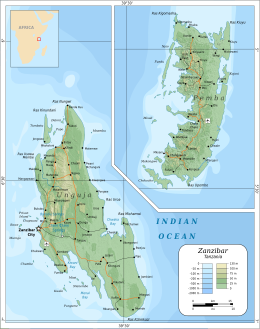Pemba, Tanzania
| Native name: Al Jazeera al Khadra (the green island) | |
|---|---|

The main islands of the Zanzibar Archipelago: Unguja (left) and Pemba (right)
|
|
| Geography | |
| Location | Indian Ocean |
| Coordinates | 5°10′S 39°47′E / 5.167°S 39.783°ECoordinates: 5°10′S 39°47′E / 5.167°S 39.783°E |
| Area | 988 km2 (381 sq mi) |
| Administration | |
|
Tanzania
|
|
| Region | Zanzibar |
| Largest settlement | Wete |
| Demographics | |
| Population | 406,808 (census 2012) |
| Pop. density | 428 /km2 (1,109 /sq mi) |
Pemba Island, known as "The Green Island" in Arabic (الجزيرة الخضراء), is an island forming part of the Zanzibar Archipelago, lying within the Swahili Coast in the Indian Ocean.
With a land area of 988 square kilometres (381 sq mi) it is situated about 50 kilometres (31 mi) to the north of Unguja, the largest island of the archipelago. In 1964, Zanzibar was united with the former colony of Tanganyika to form Tanzania. It lies 50 kilometres (31 mi) east of mainland Tanzania, across the Pemba Channel. Together with Mafia Island (south of Unguja), these islands form the Spice Islands (not to be confused with the Maluku Islands of Indonesia).
Most of the island, which is hillier and more fertile than Unguja, is dominated by small scale farming. There is also large scale farming of cash crops such as cloves.
In previous years, the island was seldom visited due to inaccessibility and a reputation for political violence, with the notable exception of those drawn by its reputation as a center for traditional medicine and witchcraft. There is a quite large Arab community on the island, who immigrated from Oman. The population is a mix of Arab and original Waswahili inhabitants of the island. A significant portion of the population also identifies as Shirazi people.
The most important towns in Pemba are Chake-Chake (the capital), Mkoani, and Wete, which is the largest city. The centrally located Chake-Chake is perched on a mound with a view to the west on a bay and the tiny Misali Island, where the tides determine when a dhow can enter the local harbour. Pemba is, with the exception of a strip of land along its eastern coast, a very fertile place: besides clove trees, the locals grow mainly rice, coconut, bananas, cassava and red beans (called maharagwe in the Swahili language).
...
Wikipedia
